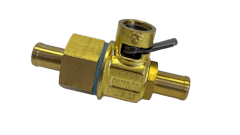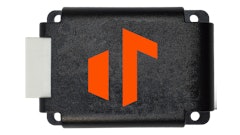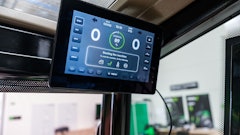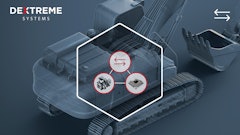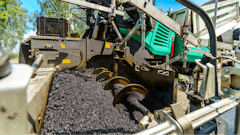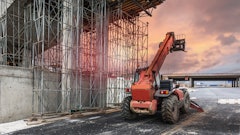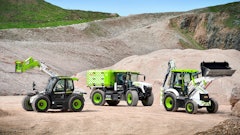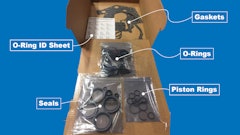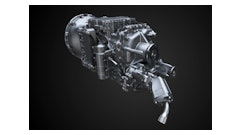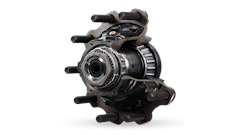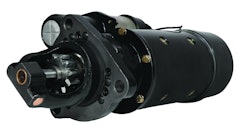
The images are far too graphic to print within this article. But if you do an Internet search on hydraulic injection injuries, you will find plenty of photos and stories that are vivid enough to make a lasting impression and, maybe more importantly, encourage you to give hydraulic systems the respect they deserve.
"Everyone needs to be aware of hydraulic system safety," says Gary Kleiner, training and development manager, Fluid Connectors Group, Parker Hannifin Corp. "It's not only the maintenance technician's responsibility, but everyone who works on and around hydraulic systems under pressure."
Of course, a lot of working with hydraulics is common sense, says Rod Erickson, senior technical instructor, Eaton Training Center. Yet, mistakes happen.
"Mistakes can happen when someone forgets to secure a load or when they forget to bleed the pressure," he says. "People can get lax when they've worked around equipment for a long time. Plus, when you're working on a repair, especially in the field, you're always under the gun. You want the machine fixed right, but you want it fixed now. Time is money and labor is expensive. As a result, you may be in a hurry and that's generally when accidents happen."
A loaded gun
When properly maintained, a hydraulic system isn't necessarily dangerous. But hydraulic hoses and assemblies do have a shelf life; when improperly stored, installed and/or serviced, they can burst and spew hot, highly pressurized fluid that can injure workers or equipment operators standing nearby.
"There is demand to increase the power density of new components," says Erickson. "With weight and space constraints, the only way we can get more power out of a hydraulic system is to increase pressure. We're going to higher and higher pressures all the time. In mobile equipment, 3,000 to 4,500 psi in continuous spaces is not unusual. And there are cases where it can get to 6,000 psi."
"With typical hydraulic systems, pressures can be 5,000 or 6,000 psi, or even higher," agrees Dennis Kemper, team leader, Global Product Application, Gates Corp.
That's a bit intense when you consider it takes just 100 psi to break skin. "A pinhole leak in a hydraulic hose that is under pressure can release hydraulic fluid at more than 600 ft. per second - close to the muzzle velocity of a gun," Kemper points out. "The very fine jet of hydraulic fluid at high pressure will act like a hypodermic needle that may penetrate both protective clothing and skin."
Such hydraulic injection injuries aren't necessarily common, but they can be life changing or. Given the potential severity of such injuries, never touch a pressurized hydraulic hose assembly with any part of your body. If you suspect a leak, use a piece of cardboard, wood or sheet metal to locate it.
Also wear safety glasses and protective gloves, along with any other personal protective equipment appropriate for the application involved. But don't expect them to prevent injection injuries. "It's instinctive to use your hand to feel for fluid leaks," says Erickson. "But keep your hands away from any suspected leaks."
If you suspect an injection injury has occurred, seek medical attention immediately. Injections may initially feel like a bee sting or wire prick, which then turns red and swells.
"Never discount an injury or brush it off as minor," says Kleiner. "Rarely does the initial pain indicate the actual severity of the injury. What looks like a simple puncture wound is, in fact, life threatening. Hydraulic fluids contain a wide range of chemical compounds that are highly toxic within the bloodstream."
Beware of hot stuff
It's important to have an arsenal of reliable diagnostic equipment for servicing hydraulic systems, including a pressure gauge (capable of handling pressures higher than the system pressure) and the hydraulic system schematic. This graphic can be found in the operator's manual or most manufacturers post it online.
Take a few minutes to review the schematic when you exhaust the pressure in the system. "It will help you identify places where hydraulic fluid could potentially be trapped," says Erickson. "Be especially watchful behind load-holding valves and counterbalance valves."
Erickson also recommends stocking your toolbox with a laser temperature gun to determine temperature at a safe distance. Since most hydraulic systems operate at 150° to 200° F, with others reaching as high as 300°, contact with leaking hydraulic fluid and metal fittings and adapters can cause severe burns. Before you work on any equipment, make sure the system has adequately cooled down.
Also keep in mind that most hydraulic fluids are petroleum based, so any leak can heighten the possibility of fire and explosion. "Even the finest of sprays from a pinhole leak can explode upon contact with a source of ignition," says Kemper. "It's important to limit or eliminate ignition sources - including electrical discharge, open flame, extremely high temperatures and sparks from metal-to-metal contact - at the jobsite or maintenance facility."
Secure for service
Hydraulic fluid creates movement of mechanical components. "A hose failure can cause these components to move or rotate at high speeds, and subsequently injure a worker," Kemper points out.
Movement can occur even after a system is bled, so be sure to mechanically secure or drop a suspended load to the ground before bleeding the hydraulics. "Always use any of the safety lockouts recommended and provided by the equipment manufacturer to ensure safe maintenance procedures," Kemper stresses. "On some equipment, once the pressure is taken off specific circuits, the boom will drop."
Make sure the power is isolated, as well. "If equipment is repaired over the course of a couple of different shifts, make sure each person working on it checks to ensure the power is off," advises Erickson. "Also test the line and bleed accumulators."
Never work on a machine with it running unless it's absolutely necessary. "Some diagnostic work needs to be done with the system running," says Erickson. "If you're checking the efficiency of the pump, you can't do it effectively without bringing the pressure up. Just make sure flow gauges, pressure gauges, etc., are well tightened down, and make sure you can view the gauge without being in a dangerous situation, such as under the load."
Before startup, ensure the unit has been adjusted to a safe operating condition, and that all personnel are aware the machine is starting up. In addition, bleed out all the air before you turn the machine over to the operator. "If you don't, you can have a cushioning effect and the system is unstable," says Erickson. "If there is air trapped in a cylinder, the air will act like a sponge. A lot of cylinders will have air bleeds on them so you can bleed [air] out."
Proper selection and handling
Safety starts with selecting the right hose. Hoses are rated, sized and designed for different applications. For example, spiral hose will be used for a different application than braided hose.
Pay attention to thread end selection, as well. Manufacturers and distributors offer manuals, tables, thread gauges and seat angle gauges to identify the appropriate coupling.
"In recent years, there has been a proliferation of thread ends from worldwide manufacturers," says Kemper. "This has dramatically increased the possibility of mismatching threads and seats. In most situations, the only visible differences between a conventional SAE coupling and a foreign coupling are the thread configuration and seat angle. And on a piece of equipment, threads and seats are not in view."
Avoid mixing and matching hose and couplings from different manufacturers. Each manufacturer designs a coupling to properly fit its own hose manufacturing tolerances. An improperly coupled hose will likely blow off or leak, causing downtime and possible personal injury.
Temperature extremes, high humidity and oil can all negatively affect hose life, Kleiner comments. "Store hoses capped in a cool, dark place," he advises. "Operating environment also plays a role, such as how often hoses are under pressure, pressure surges, etc."
During installation, be careful not to twist the hose or exceed the recommended bend radius. Use the correct hose length, and avoid routes that cause the hose to bend immediately behind the coupling or promote rubbing and abrasion.
When it comes to maintenance, be proactive. All hydraulic hose is stamped with a manufacture date, so replace any hose that has "expired." Check hoses routinely for cuts, abrasions, cracks, etc. And don't forget to check fittings; if they're damaged, they can also promote a failure.
"Be proactive," emphasizes Kleiner. "Being reactive will cost you money in downtime and repairs."



